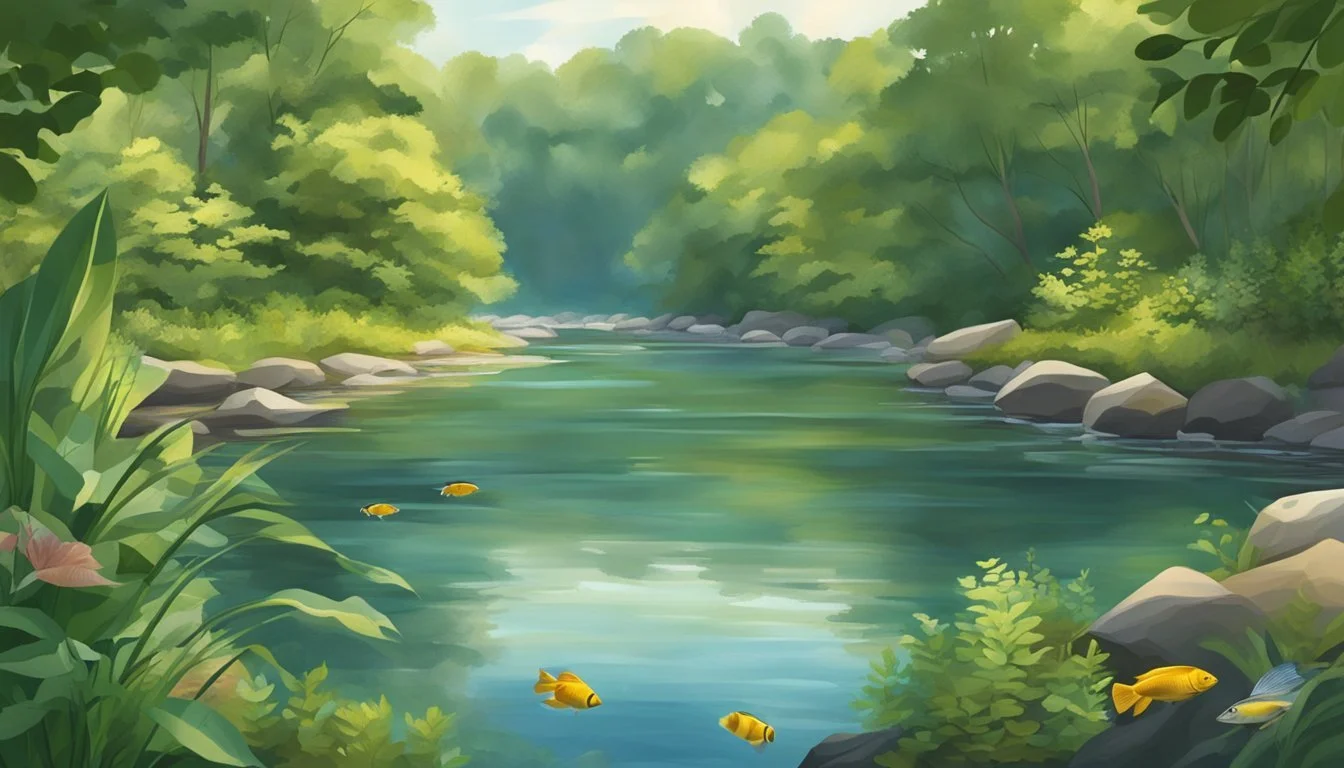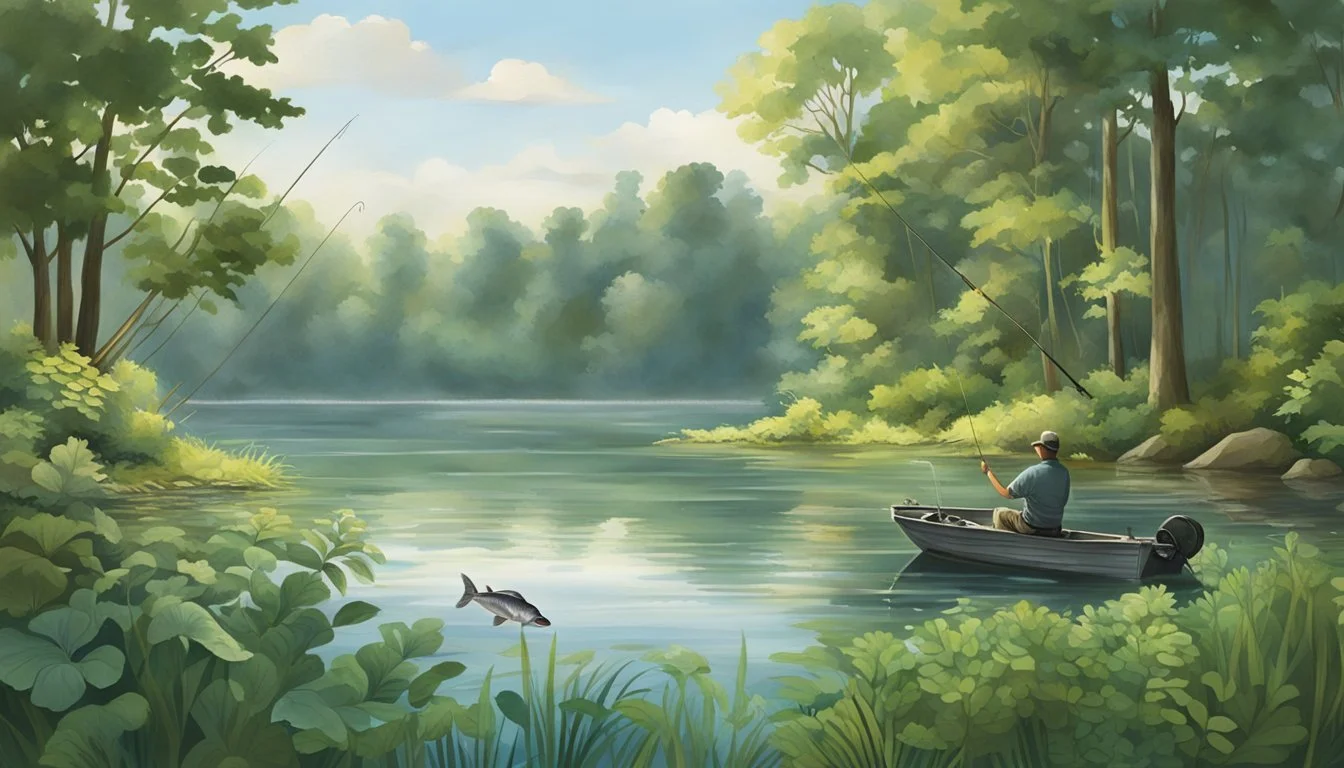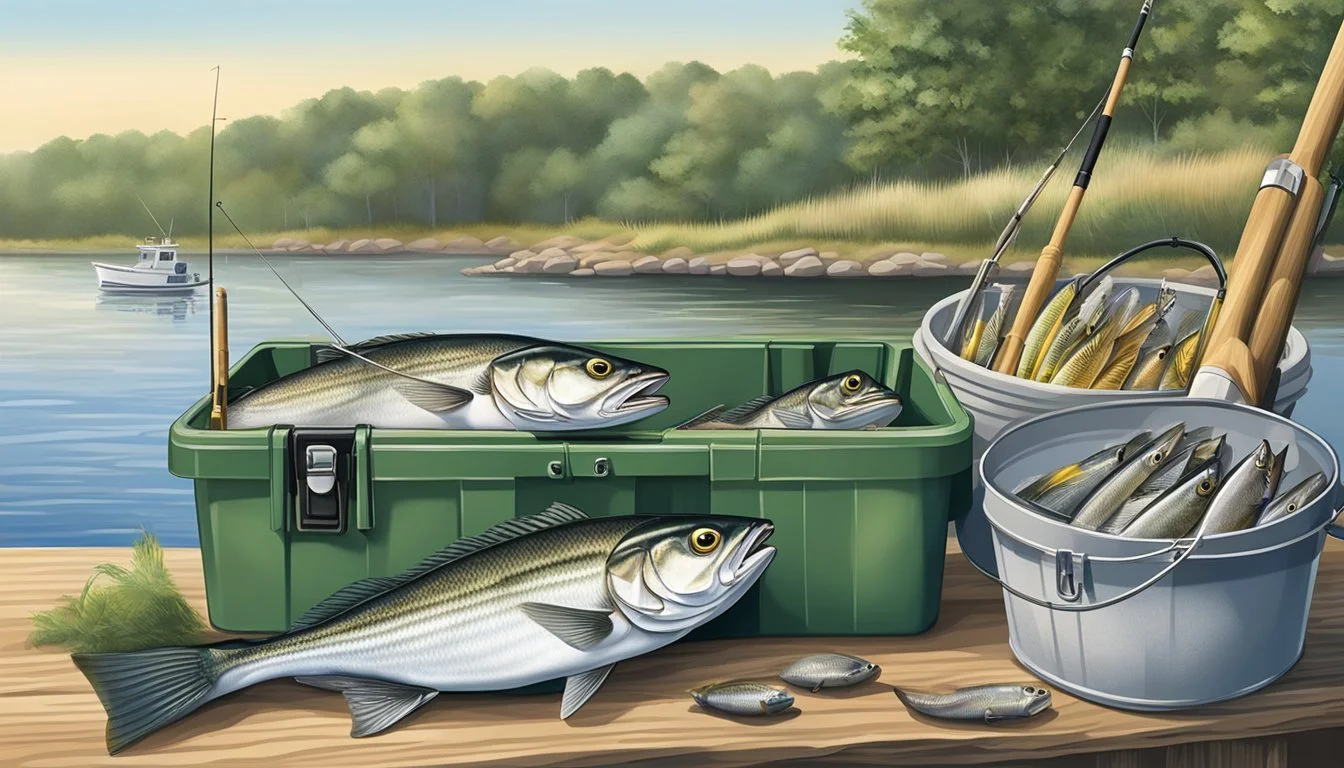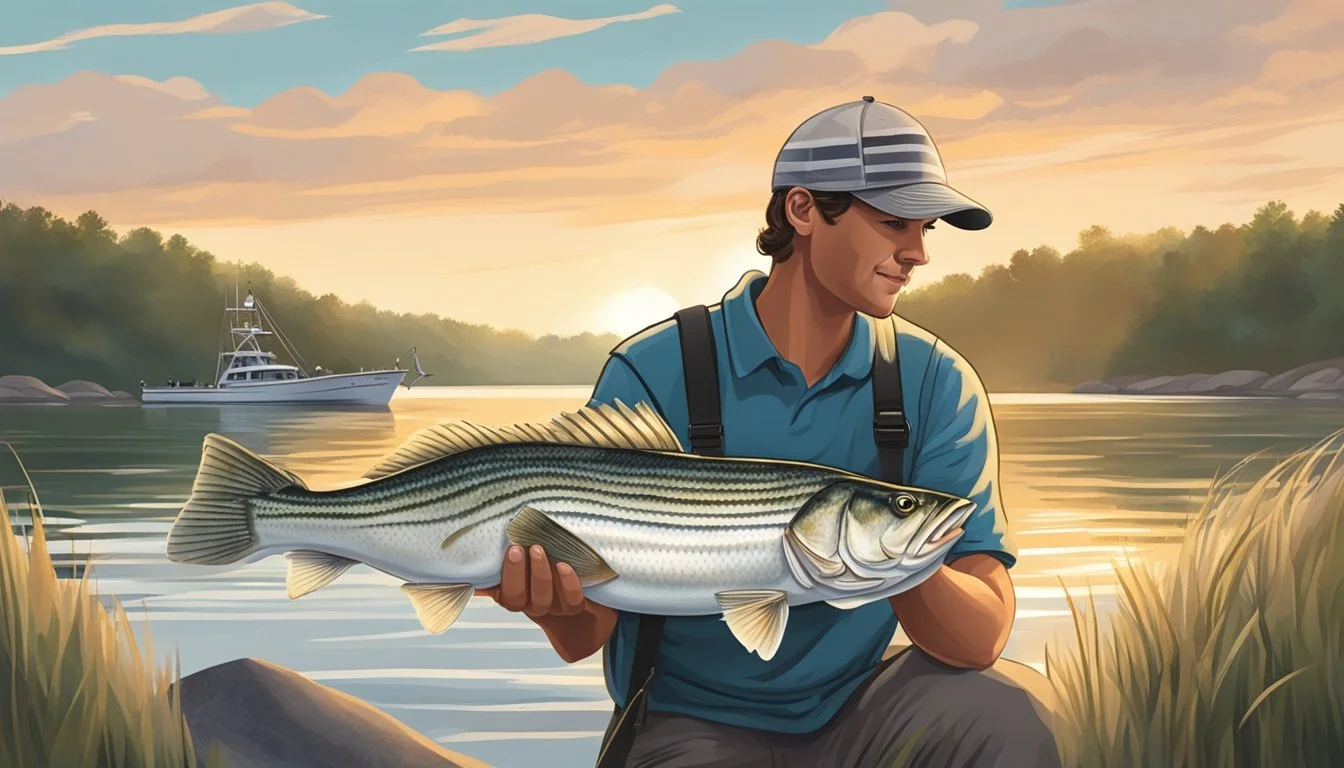Best Fish to Catch and Eat in Maryland
Your Ultimate Guide
Maryland is heralded for its diverse aquatic ecosystems, spanning from the vast Atlantic coastline to numerous rivers and estuaries, making it a prime destination for anglers. Among the best fish (What wine goes well with fish?) to catch and consume in the region, the Striped Bass, locally known as Rockfish, holds the title of the state fish and is highly treasured for its firm, flavorful flesh.
The fishing landscape in Maryland offers a variety of species beyond the famed Rockfish. Anglers can look forward to the likes of Tautog, known for their tasty meat, as well as Flounder and Trout. Whether one prefers the challenge of deep-sea fishing or the tranquility of casting a line from the shore, Maryland’s waters provide a rewarding experience, coupled with the opportunity to enjoy freshly caught fish.
The state accommodates fishing enthusiasts year-round, with peak seasons running from April to September for a multitude of species. This period is optimal for catching Striped Bass, Bluefish, Tuna (What wine goes well with tuna?), and Largemouth Bass, among others, with each offering a unique flavor and texture to suit a variety of culinary preferences.
Understanding Maryland's Ecosystem
Maryland's ecosystem is a complex web of freshwater and saltwater habitats, each with its unique characteristics and species. The Chesapeake Bay, a central figure in this diverse ecological tapestry, plays a crucial role in the health and sustainability of Maryland's aquatic life.
Freshwater Habitats
Maryland's freshwater habitats include an extensive network of rivers and streams that harbor a rich variety of aquatic vegetation and fish species. These freshwater bodies range from the rushing waters of the Youghiogheny River in the west to the tranquil streams on the Eastern Shore. Aquatic vegetation in these environments provides critical shelter and breeding grounds for many fish species, supporting a thriving ecosystem.
Key Freshwater Features:
Rivers: Potomac, Susquehanna, Patapsco
Notable Fish: Trout, Bass
Aquatic vegetation includes: Wild Celery, Water Willow
Saltwater Habitats
Maryland's coastal waters along the Atlantic Ocean offer saltwater habitats that are markedly different from the freshwater streams and rivers. These saline environments support species well-adapted to the conditions, such as Striped Bass, commonly known as Rockfish, and Flounder. The variety of fish speaks to the robustness of Maryland's salty maritime domain, which includes everything from shallow estuarine areas to the deeper waters off the coast.
Key Saltwater Features:
Locations: Atlantic coastline, Coastal bays
Notable Fish: Rockfish, Bluefish, Flounder
Vegetation: Seagrasses like Eelgrass
Chesapeake Bay Ecosystem
The Chesapeake Bay, the largest estuary in the United States, serves as a bridge between freshwater and saltwater habitats, making it a dynamic and essential ecosystem in Maryland. It is home to over 300 species of fish, such as the famous Blue Crab (how long does crab last?)and various species of Tautog, and Trout. The health of the Bay is tied to the health of its aquatic vegetation, which includes expansive underwater grass beds important for water filtration and providing a habitat for juvenile fish.
Chesapeake Bay Highlights:
Fish Species: Blue Crab, Tautog, Menhaden
Vegetation: Submerged aquatic vegetation like SAV beds
Importance: Serves as a nursery for numerous fish and shellfish species
Regulations and Licensing
In Maryland, engaging in fishing activities legally requires adherence to specific licensing requirements and regulations. The rules vary depending on the type of fishing - whether in freshwater or saltwater - and they are strictly enforced to ensure sustainable fishing practices.
Fishing License Requirements
In Maryland, anyone above the age of 16 must obtain a fishing license to fish in the state's freshwater bodies as well as in the Chesapeake Bay and Atlantic Ocean. Licenses can be purchased from the Maryland Department of Natural Resources or authorized agents. There are different types of licenses available:
Annual Non-tidal License: allows fishing in the freshwaters of Maryland for one year.
Short-term License: a temporary option for tourists or short-term visitors.
Annual Chesapeake Bay & Coastal Sport Fishing License: required for the Chesapeake Bay and its tributaries as well as the Atlantic Ocean and coastal bays.
Exemptions apply for certain groups, including anglers under 16, Maryland residents on leave from active military service, and individuals fishing on their own private property.
Fishing Regulations and Seasons
Maryland's fishing regulations are dynamic and encompass aspects such as seasons, minimum sizes, and daily catch limits to foster environmental stewardship. Regulations differ between freshwater and tidal waters, including the Chesapeake Bay and Atlantic Ocean. Key regulations include:
Seasons: Specific times of the year when certain fish may be caught.
Size limits: Minimum and maximum lengths for keeping certain species.
Creel limits: The number of fish an angler can keep in a day.
For accurate and up-to-date information, anglers should consult the Maryland Department of Natural Resources. They provide detailed seasonal charts and regulative updates vital for every angler's compliance. It is the responsibility of each angler to be informed and act within the legal stipulations to avoid penalties and contribute to the conservation of Maryland's aquatic ecosystems.
Popular Fish Species in Maryland
Maryland offers a diverse range of fish species for anglers and seafood lovers to enjoy. From the prized Striped Bass to the challenging Trout, the state's waters are teeming with fish that are both enjoyable to catch and delicious to eat.
Striped Bass (Rockfish)
The Striped Bass, locally known as Rockfish, is Maryland's state fish and a favorite among anglers. Striped Bass can grow to impressive sizes and are renowned for their fighting spirit. They can be found in the Chesapeake Bay and along the Atlantic Coast.
Black Bass Varieties
There are two primary types of Black Bass that can be caught in Maryland: the Smallmouth Bass and the Largemouth Bass. The Smallmouth Bass is often found in cool, clear streams and rivers, while the Largemouth Bass prefers warmer, murkier waters, such as those found in ponds and lakes.
Smallmouth Bass:
Habitat: Streams, Rivers
Characteristics: Prefers cool, clear waters
Largemouth Bass:
Habitat: Ponds, Lakes
Characteristics: Prefers warm, murky waters
Trout Species
Maryland's freshwaters are also home to several species of Trout, including Rainbow Trout, Brown Trout, and Brook Trout. These fish are sought after for both their sport and culinary qualities. Trout fishing can be particularly rewarding in Maryland's mountain streams.
Rainbow Trout: Known for their vibrant stripes, they thrive in cooler water conditions.
Brown Trout: Notoriously elusive, offering a challenge to anglers.
Brook Trout: Maryland's native trout, typically found in smaller, cold streams.
Other Notable Fish Species
Beyond Bass and Trout, Maryland's waters host a variety of other fish species that anglers might encounter. These include:
Perch: Including Yellow Perch and the rarer White Perch.
Flounder: Flatfish that are mostly sought in the coastal bays.
Bluefish: Aggressive sport fish found in the Chesapeake Bay and Atlantic Ocean.
Croaker: Bottom-dwelling fish known for the croaking sound they produce.
Catfish: Including Channel Catfish, which can be found in many of Maryland's freshwater systems.
Northern Pike and Chain Pickerel: Both offer a thrilling fishing experience and can be found in several of Maryland's lakes and rivers.
Cobia: A migratory species that can occasionally be encountered in the warmer waters of the Chesapeake Bay during summer.
Each of these species adds to the rich tapestry of Maryland's aquatic life, providing anglers with a wide selection of fish to pursue and enjoy upon the plate.
Fishing Techniques and Strategies
Maryland offers anglers diverse opportunities to catch various species using specialized techniques in both freshwater and saltwater environments. From selecting the appropriate lures to mastering the art of casting, understanding these methods can significantly enhance the fishing experience.
Freshwater Fishing Techniques
Freshwater fishing in Maryland's lakes, rivers, and reservoirs demands a strategic approach to targeting species like largemouth bass and catfish. Anglers often employ live bait such as worms, crayfish, or minnows for an effective lure. Casting techniques vary with the target species and fishing spots, but a common strategy is to cast near structures where fish tend to congregate. For bottom-feeders such as catfish, using cut fishing baits or dough balls can prove successful.
Saltwater Fishing Methods
Saltwater fishing in Maryland, particularly in the Chesapeake Bay or along the Atlantic coast, opens up the chance to catch species such as striped bass and bluefish. Anglers may embark on deep sea fishing trips or choose shore fishing, each requiring different strategies. Deep sea fishing often involves trolling or bottom fishing with heavy tackle, while shore fishing may employ surf casting to reach the schools of fish. The selection of the right size and type of lure is crucial, and using a guide can provide valuable local knowledge for optimal results.
Fly Fishing
Fly fishing in Maryland streams and creeys is a skillful endeavor that appeals to those seeking to connect with the intricate dance between angler and fish. Target species include trout and smallmouth bass, which offer a spirited fight when hooked. Fly anglers must master the delicate presentation of the fly, often imitating local insects, and precise casting techniques are a must. A variety of flies and methods can be used depending on the season and behavior of the target fish.
Fishing Locations and Hotspots
Maryland offers a diverse range of fishing environments, from the bustling coastal waters of the Atlantic Ocean to serene inland havens teeming with sought-after freshwater game fish. Enthusiasts can find an assortment of species across various hotspots dictated by the state's unique geography.
Rivers and Streams
One of the prime locations for river fishing is the Potomac River, especially the southern parts where anglers often pursue blue catfish and northern snakehead. Gunpowder Falls is another prominent stream, maintaining a reputation for its trout fishing opportunities.
Lakes and Reservoirs
For lake fishing, Deep Creek Lake stands out with its array of bass, bluegill, and northern pike. In central Maryland, the Liberty Reservoir is known for hosting a mixture of fish species, including the elusive walleye, which often gather around deep-water drop-offs.
Coastal and Ocean Fishing
The coastal city of Ocean City provides access to the Atlantic Ocean, where seasoned fishers can chase species like tuna and sea bass. Surf fishing and deep-sea excursions are both popular here, with the diverse marine ecosystem offering year-round angling adventures.
Seasonal Fishing and Year-Round Opportunities
Maryland offers a rich variety of fishing experiences throughout the year, each season bringing its unique opportunities. Anglers can enjoy everything from ice fishing in the colder months to crabbing in the warmth of summer.
Ice Fishing
During the winter, Maryland's colder temperatures create the ideal conditions for ice fishing, particularly in the western region. Deep Creek Lake is a popular destination, where one can catch various species of trout. Anglers should ensure that the ice is at least four inches thick for safety and abide by local regulations regarding ice fishing practices.
Crabbing Seasons
Crabbing, especially for the renowned Maryland blue crab, is a celebrated activity that peaks from late spring through early fall. The best months for crabbing usually span between April and December, with the highest yield often reported in August. It's important for crabbers to note the state's regulations, such as size restrictions and catch limits, to sustainably enjoy this cherished Maryland pastime.
Additional Fishing Activities and Species
Maryland offers a diverse range of fishing activities targeting a variety of species beyond the common catches. Anglers can pursue everything from game fish to exotic invaders, all while practicing conservation-minded angling.
Targeting Game Fish
Maryland's waters are home to several sought-after game fish, making it an exciting destination for sports fishermen. Striped bass, also known as rockfish, is arguably the most popular game fish in the state, thriving especially in the Chesapeake Bay. Anglers can also seek out cobia and redfish for a challenging and rewarding experience on the water. Freshwater fisheries, on the other hand, see enthusiasts angling for walleye, crappie, and varieties of trout.
Billfish: Rare but thrilling, anglers might encounter species like marlin on offshore trips.
Tuna: Another offshore prize, tuna species offer an intense battle for those willing to venture further into the Atlantic.
Exotic and Invasive Species
Some non-native species have established themselves in Maryland's ecosystems, offering unique angling opportunities. Northern snakehead, an invasive species, can be found in various tributaries of the Chesapeake Bay. While they are detrimental to local ecosystems, they provide an interesting challenge for anglers.
Carp: These fish, while often overlooked, can provide an exhilarating catch due to their size and strength.
Sunfish Family: Including species such as bluegill and pumpkinseed sunfish, these fish are abundant and enjoyable to catch for all ages.
Conservation and Ethical Angling
Ethical fishing practices are essential to maintain the health of Maryland's aquatic ecosystems. Anglers are encouraged to understand and follow local regulations to support fish populations. This includes catch-and-release of certain species and adhering to size and bag limits.
Sharks: With various shark species inhabiting Maryland's waters, anglers must be aware of the specific regulations governing their capture.
Catch-and-Release: Game fish like marlin and some species of shark are often subject to catch-and-release to ensure their populations remain robust.
Insects: As a critical part of the food web, many anglers opt to use artificial lures mimicking insects to minimize the impact on native species.
Preparing Your Catch
After a successful day of fishing in Maryland, ensuring the quality and flavor of your catch begins with proper cleaning and storage. These initial steps are crucial to preserving the best fish you've caught for an enjoyable eating experience.
Cleaning and Storage
The first step after catching fish is to clean it properly. It's important to begin the cleaning process as soon as possible to prevent spoilage. One should start by descaling the fish, removing the scales with either a knife or a fish scaler. Next, they should remove the guts and gills, taking care to rinse the body cavity thoroughly. After cleaning, they should store the fish at a cold temperature. If one is out at sea or on a riverbank, they should place the fish on ice immediately.
Below is a guideline for storing different types of fish:
Striped Bass & Bluefish: Keep on ice and consume within 3-5 days.
Tuna: Best when fresh; refrigerate and eat within 1-2 days.
Flounder & Trout: Remain fresh 2-3 days on ice; store in the coldest part of the refrigerator.
Cooking Recommendations
The best way to cook fish depends on the species and personal preference. However, there are general recommendations that they can follow to enjoy a sumptuous meal.
For striped bass and bluefish, grilling, broiling, or baking are recommended. To enhance the flavor, one can marinate them or add a dash of lemon before cooking. For tuna, searing or grilling over high heat is ideal. They should cook it rare to medium-rare to retain moisture and flavor.
Here are simple cooking methods aligned with each fish:
Largemouth Bass: Pan-frying in butter; seasoning with salt, pepper, and lemon.
Catfish: Dredge in cornmeal (how long does cornmeal last?) and fry; accompany with a spicy remoulade.
Redfish: Blacken in a cast-iron skillet and serve with a Cajun-style sauce.
For additional flavors, one can incorporate Old Bay seasoning, (how long does old bay seasoning last?) a Maryland staple, especially when steaming seafood like crabs. Each fish has its unique taste, so seasonings should enhance rather than overpower the natural flavors.
By utilizing these guidelines, anglers ensure that their catch retains its freshness and is prepared to culinary perfection.
Fishing Resources and Community
Maryland's fishing resources span from informative charters and guides to bustling tournaments. The community takes advantage of the extensive coastline, including Annapolis and myriad spots for shore fishing.
Charter Fishing and Guides
For those new to fishing or looking to hone their skills, Maryland offers a variety of charter fishing services. In Annapolis and along the coastal regions, one can find expert guides to navigate the bountiful waters. Charter fishing not only provides boats and equipment but also the invaluable knowledge of seasoned professionals who know the local waters intimately.
Annapolis Charters: Specializing in Chesapeake Bay trips
Coastal Charters: Offering tailored experiences for shore fishing enthusiasts
Tournaments and Competitive Fishing
Competitive fishing is a cornerstone of Maryland's fishing community, with numerous tournaments held throughout the year. These events range from casual local competitions to high-stakes professional contests, attracting anglers from across the nation.
Annual Chesapeake Bay Tournaments: Featuring the sought-after striped bass
Local Trout Competitions: Celebrating Maryland’s freshwater fishing heritage
Engagement in these community offerings not only offers the thrill of the catch but also contributes to sustainable fishing practices and the conservation of Maryland's diverse marine life.
Supplies and Equipment
Before heading out to Maryland's prime fishing spots, anglers should ensure they have the right supplies and equipment for a successful and enjoyable experience. From selecting effective lures to pairing the proper rods, reels, and line, the choices made in gear can significantly influence the day's catch.
Choosing the Right Lures
Lures are crucial in enticing fish, and choosing the right one can make the difference between a good or bad fishing day. In Maryland waters, diverse fish species may respond better to different types of lures:
Tautog: They respond well to crab imitations since crustaceans are a significant part of their diet.
Smallmouth Bass: A variety of lures can be used, but crankbaits and spinnerbaits are highly effective, especially around stumps and structure.
It's advisable for anglers to carry a mix of these lures to adapt to the active feeders in Maryland's fishing spots.
Rods, Reels, and Fishing Line
The right combination of rods, reels, and fishing line is paramount for both casting accuracy and handling the fish once hooked. Key considerations include:
Rods: Medium to heavy action rods are suitable for the variety of freshwater and saltwater species found in Maryland.
Reels: Spinning reels are favored for their versatility, and baitcasting reels are preferred by those targeting larger species.
Lines: Braided lines are a good choice for their strength and sensitivity, allowing anglers to feel the slightest bites.
Combining these elements should reflect the angler's target species and fishing environment.
Bait Selection
Live bait often yields a higher success rate due to its natural appeal to fish. When fishing in Maryland, the following live bait selections are among the most effective:
Worms: Universally appealing, particularly for trout and panfish.
Minnows: Excellent for predatory fish such as bass and pike.
Here's a quick reference for bait choice:
Bait Type Target Fish Worms Trout, Panfish Minnows Bass, Pike
Fishermen should consult local bait shops like Anglers in Annapolis for local expertise on the best bait selection for current conditions.
Conclusion
Maryland offers a diverse fishing landscape, ranging from the rich estuaries of the Chesapeake Bay to the freshwater tributaries and lakes dotting the region. Tautog (Blackfish), known for their challenge to catch and excellent taste, stand out as a top choice for anglers seeking both a rewarding experience and a delectable meal.
Flounder and Trout also present good opportunities for anglers in Maryland, each bringing its own unique qualities to the table. Flounder are prized for their delicate flavor, while Trout are a favorite for their sporty catch.
For those interested in ice fishing, Deep Creek Lake is highlighted as the largest freshwater lake in Maryland, offering fishing experiences even in the colder months. Meanwhile, the Chesapeake Bay remains a consistent destination for a variety of fish, showcasing some of the most productive fisheries on the East Coast.
Fish Species Known For Best Locations Tautog Taste & Challenge Coastal wrecks Flounder Delicate flavor Bays and coastal waters Trout Sporty catch Rivers and freshwater Various Diverse experiences Chesapeake Bay
Anglers in Maryland can look forward to a range of fishing experiences, from serene freshwater fishing to the adventurous pursuit of the elusive Tautog in coastal wrecks. The state's waters cater to various skill levels and preferences, ensuring that every fishing trip can be as engaging and gratifying as possible.








